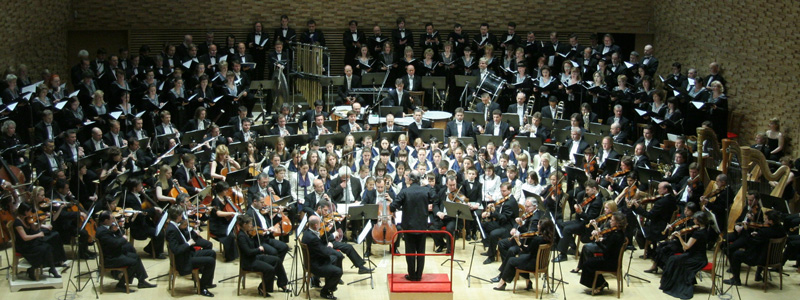Musical Preparation: Leonid Zolotarev
Principal Chorus Master: Andrei Petrenko
Artistic Director of the St Petersburg TV and Radio Children's Chorus: Stanislav Gribkov
Conductor of the Mariinsky Off-stage band: Alexei Repnikov

Gustav Mahler's Eighth Symphony (1906) is often compared and ranked alongside Beethoven's Ninth, with its concluding Ode to Joy. In the composer's mind, the Eighth Symphony was to be a lofty ode to mankind, his creative spirit, an ode to beauty and Goethe's "eternal femininity". At the same time, Mahler saw it as a "symphony of symphonies", a crowning symphonic épopee which the composer wrote over a period of two decades. In other words, the Eighth Symphony took on the role of the finale of the super-cycle of all of Mahler's symphonies.
The plan required the composer's gathering together immense performing abilities: an enlarged symphony orchestra, organ, two mixed choruses, boys' choir and soloists - three sopranos, two altos, a tenor, baritone and bass.
Written in summer 1906, the symphony was first performed in Munich on 12 September 1910. The premiere was a resounding success. Offhandedly the impresario called the Eighth the "Symphony of a Thousand", which Mahler himself rejected as being an advertisement. But at the same time the composer underlined the truly universal scale of his work. In a letter to Dutch conductor Willem Mengelberg, Mahler wrote: "Ihave just finished my Eighth Symphony - the most magnificent of anything Ihave done up till now. The work is so unique in content and form that it is impossible even to describe it in a letter. It seems that the whole universe is stirring and coming to live in sound; it is not only human voices, but those of the turning planets and the sun..."
We have before us a grandiose symphonic cantata: Mahler is drawn to the poetic word, to voices singing aloud for the first time throughout the entire work (unlike the Second, Third and Fourth Symphonies, where the spoken word is "summoned" only at the culmination for a more complete expression of the principal idea). Some researchers even call the Eighth a "symphony-oratorio": "it is to vast to be a cantata" (K. Rosenshild).
The basis for the first movement of the symphony comes from the ecclesiastical Catholic hymn to the Holy Spirit "Veni, creator spiritus". The second movement is set to words from the final scene in Goethe's Faust. Medieval Latin and German, the ages of Enlightenment of the 19th and 20th centuries, a canonical religious text and one of the greatest creations in belles lettres... What is it that unites them? The search for higher harmony, an untiring striving towards it, which half a century later a Russian poet would bring together in the brilliant poetic formula "both art and miracle-making" (B. Pasternak).
Mahler's Eighth could almost have been written for the operatic stage. Here the power and beauty of the orchestral and choral episodes are combined with the detailed solos and ensembles, drawing towards to chamber-like expressiveness.
Initially Mahler intended to dedicate his Eighth Symphony to the German people. But he rejected this plan his own passionate words: "Iam a man who has lost his homeland three times: as a Czech among Austrians, as an Austrian among Germans and as a Jew throughout the world." The authoritative Mahler expert Paul Bekker confirmed that the Eighth was dedicated to all humanity. The composer himself limited himself to a modest dedication on the title page of the score: "To my beloved wife Alma Maria".
It is in Mahler's letters to Alma that we find the composer's exhaustive interpretation of the final verses in Goethe's Faust. It sheds light on Mahler's entire idea: "Everything transient is a mere symbol, a comparison which, expressed in the language of earthly phenomena, is only approximate, the notes are faced with something free of the flesh of earthly approximateness, and then we need neither allegorical descriptions, nor comparisons, symbols, there we have what Ihave tried to describe here but which is impossible to describe. Why? Ican answer you only through a symbol: we are drawn by the eternally feminine - we have attained it - we are at rest - we have in our hands that which on earth we could only reach for and strive towards. Christ calls this eternal bliss..."
The achievement (or rather, the process of achieving, i.e. this striving towards this heavenly harmony) is the prerogative of the creator, the creative spirit, the eternally masculine - hence the choice of the hymn "Veni creator spiritus" as a gigantic prologue to the culminating scene in Faust. Hence the very choice of form for this, Mahler's crowning achievement, the choice of the genre of the symphony mass (or mass symphony) as a complete expression of the essence and role of the symphony in the post-Beethoven world - in the words of P. Bekker, the secular mass. Hence the address to the Creator: both directly - in the church hymn - and indirectly - in Goethe's poem. Here Mahler repeats his beloved Fyodor Dostoevsky: "Here the Holy Spirit is a direct understanding of beauty, a prophetical consciousness of harmony, ultimately an unflinching striving towards it".
Iosif Raiskin
